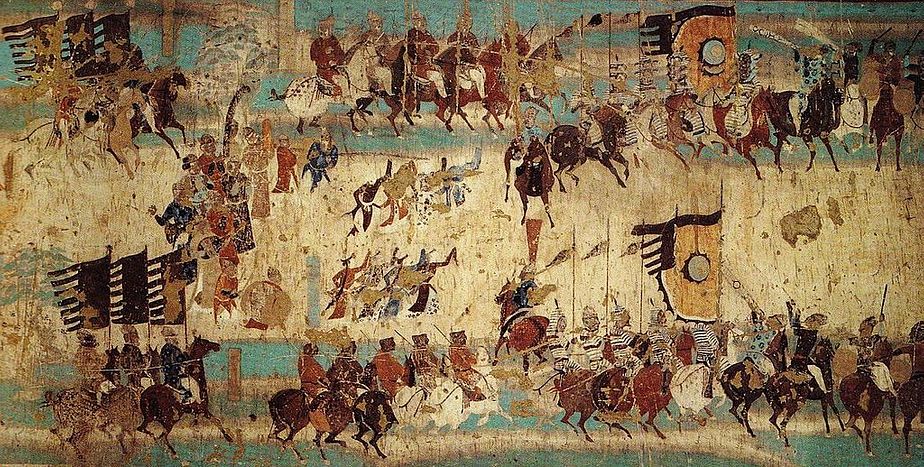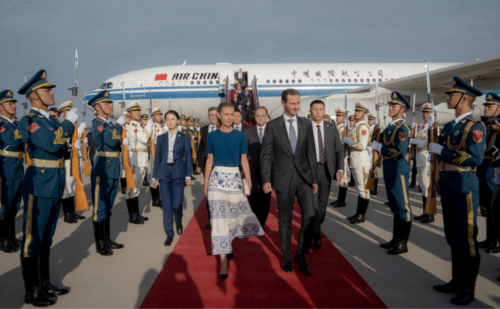This Week in China’s History: July 751
In the 8th century, two enormous empires were spreading across Asia from opposite directions. From the east, Tang China was the largest empire in East Asia since the Han Dynasty fell in the 3rd century. From the west, the Abbasid Caliphate had just recently wrested power from the Umayyads, and was now expanding across the Middle East, from North Africa into Central Asia.
In July of 751, somewhere in the Talas River valley along the border of what are today Kazakhstan and Kyrgyzstan, the armies of these two empires clashed. After five days of battle, the Tang was defeated. Never again would a Chinese state extend this far west, and within five years Tang forces would largely withdraw from the region. Islam spread across Central Asia, while Buddhist influence diminished. The Battle of the Talas River is thus often presented as a major watershed in world history, the “high water mark” of Chinese power, the collision of two empires.
But rarely does history pivot on a single moment, and this is no exception.
The Tang Dynasty originated in 618 after its predecessor, the Sui, had reassembled much of the former Han empire following centuries of fragmentation. Within a century of its founding, the Tang Empire would extend from the Pacific to Afghanistan, exceeding even the fabled Han Dynasty. Its founding Li family was tied through kin and culture to the Turkic peoples of Central Asia, and the Tang developed into China’s most cosmopolitan age.
Its expansion was not unchallenged. Tang armies fought, with mixed success, against hostile neighbors on all sides, from the Nan Zhao kingdom and Tibet on the south to Korea on the northeast and the Uyghurs and Kitans on the north.
Meanwhile, at the other end of Asia, Tang’s western neighbor was in turmoil. The Umayyad Caliphate, in place since the 660s, fell to a rebellion led by Persians against the Arab ruling class. In 750, the new Abbasid rulers assumed control over an immense Islamic empire, smaller than Tang but still reaching from Spain across North Africa to the Arabian Peninsula, and then east through Persia and Afghanistan.
The conflict that led to the Battle of Talas River began with this rebellion that brought the Abbasids to power. Seeing their rival destabilized, the Tang moved to solidify their western frontier, separated from the capital at Chang’an (now Xi’an) by nearly 3,000 miles of deserts and mountains. In the spring of 750, the dynasty sent its preeminent general in the region, Go Seonji (he was ethnically Korean, but I will refer to him by the Chinese version of his name, Gāo Xiānzhī 高仙芝) against the city of Gilgit, controlled by the Tibetan empire. A brilliant tactical victory secured Tang power in the area, and Gao was made its governor.
Their presence in the region dragged the Tang into more local disputes. The city-states of Ferghana and Tashkent, thriving Silk Road trading entrepots, now called on the two empires in the region for aid in their long-standing rivalry. Ferghana looked to Tang, and Tashkent, in turn, sought help from the nearby Abbasids. In July 751, Abbasid armies under Ziyad Ibn Salih encountered the Tang armies of Gao Xianzhi.
What happened next is difficult to know with precision. (A thorough discussion of events took place on the BBC4 radio show In Our Time in 2016.) As with any event this long ago, sources are neither plentiful nor consistent: spare references in the official histories of the Tang and subsequent Song dynasties, as well as the diaries of a Chinese prisoner of war named Dù Huán 杜环, whose account survives, in fragments, in other works. The Iranian scholar al-Tabari (839-923) chronicled events from the Abbasid side, but even these sources are skeletal.
The best estimates are that both sides marshaled between 30,000 and 50,000 soldiers (though some estimates claim much greater numbers). The Abbasids were a mix of Arab, Tibetan, Turkic, and Persian troops. The Tang armies were Chinese along with local allies.
The two sides faced off with archers in front and spearmen in the second line. Behind the Abbasid lines were heavy cavalry — which the Tang did not possess. On the flanks of the Tang army were Karluk Turks.
For three days, crossbows and superior armor gave Tang the upper hand. But on the fourth day — some sources say the fifth — the battle turned decisively when the Karluk Turks, which had been little involved in the fight up to then, turned on their Chinese allies and attacked the Tang flanks. With the Chinese forces engaged, the Abbasid army overwhelmed them from the front. Only a few thousand Tang men survived, Gao Xianzhi among them. Many thousands were taken prisoner.
The role of the Karluks is hotly debated. In this fluid environment far from major power centers, alliances were quickly made, and unmade, so the fact that the Karluks changed sides is not shocking. Some sources contend that the Abbasids had coordinated the change before the battle even began. Tang sources see the move as outright treachery. In either case, the Karluk switch to the Abbasids was decisive.
After the battle of Talas River, several important trends came to a halt: Tang westward expansion, Buddhist influence across Central Asia, ideas and goods flowing between India and China are just some of them. Central Asia became increasingly Muslim, fundamentally shaping the histories of many regions, including Xinjiang.
Touching off these epochal shifts, it seems clear that the 751 battle was a watershed moment in world history.
But to what extent?
The Abbasids did not follow up their victory with further expansion. Instead, Tibetans, Uyghurs, and other groups moved into the territory where the larger empires had fought. But this was not directly because of the Talas River battle. Tang armies didn’t withdraw fully from the region until the An Lushan rebellion started in 755. That event shook the Tang to its foundations and reshaped China for centuries.
The battle’s outcome did disrupt overland commerce between Central and Western Asia and China, but the sea route had always been an important link between the Middle East and East Asia, and it remained so.
Likewise, the decline of Buddhism in Central Asia had many causes, not just this one battle. The influx of Islam played a role, but so did the revival of Hinduism in India, which put an end to the source of Buddhist texts and ideas for the overland transmission to China.
Finally, anecdotes suggest that papermaking reached the Arab world, and eventually Europe, through Tang prisoners of war. But specialists in the era are, at best, skeptical of this. It is true that paper doesn’t appear in Baghdad and other core Middle Eastern regions until after the Talas River battle. However, there was widespread use of paper — though not necessarily paper produced there — in Central Asia hundreds of years before, and transmission along existing routes seems a more probable explanation than the romantic notion of prisoners.
The most poignant echo of the Talas River battle is not a break with the past, but a continuation. Empires have long sent their soldiers to war, to die far from home. Historians are often struck, reading about the past, of how familiar what went before can seem. I had that feeling reading these words by that most esteemed Tang poet, Lǐ Bái 李白, who wrote this poem, we think, after receiving news of the Tang defeat at the Talas River. Its story of power projected too far, and soldiers dying far from home, remains, sadly, familiar.
Fighting South of the Wall (translated by Elling Eide)
Last year fighting at the source of the Sang-kan,
This year fighting on the Onion River road,
They have washed their weapons in the waves on the seas of T’iao-chih;
They have pastured their horses on grass
In the snows of the T’ien -shan.
Across ten thousand miles the long campaigns and battles,
The Three Armies completely exhausted and old
…
The signal fires burn without ceasing.
The long campaign has no time for ending.
Fighting in the wilds they die in hand to hand combat;
The losers’ horses cry and sorry toward Heaven.
Crows and kites peck at human intestines
And carry them off to hang them from withered trees.
Soldiers are splattered all over the weeds and the grasses,
And being a general is something useless to be.
Then known that weapons are truly the tools of misfortune,
Only used by The Sage when he has no other way.
This Week in China’s History is a weekly column. Last week:
“A revolutionary against empire and patriarchy”: The execution of Qiu Jin






